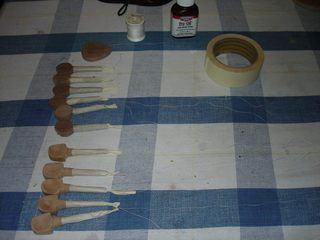
Today I put on the finish. This is always a fun part because I get to see what the neck will look like when it is all done. I also put some finish on the pegs and tailpieces of both banjos.
It is necessary to keep the finish off of the part of the peg that fits into the peghead hole. So I masked off all of the peg shafts with masking tape.
If you look closely you can see that I have taped a thread to the end of each of the pegs. I used the threads to hang these parts up for finishing. That makes it easier to keep them clean while they dry.
When I went out to my banjo necks I found that they felt quite rough from the staining. I guess the water raised the grain of the wood more than I thought it would. I decided to try to smooth them out a bit before putting on the finish. Somebody told me that it is OK to sand the wood after it has been stained and it won't affect the color. So like an idiot I tried it by gently sanding the neck with some 220 grit paper. The color came off immediately where I sanded it. Shoot!
To make things worse I did my little experiment on the most visible part of the neck, the finger board. It looked horrible. I was stuck with staining the neck all over again. While I was at it, I added some stain to the finger board of the other neck as well just for the heck of it. Here is a photo of the necks drying.
Of course, I then had to wait for the necks to dry before I could add the finish. I also had to deal with the fact that the new staining had raised the grain again. While the necks were drying I remembered an old trick from back when I was finishing wood using tung oil. The last step of the process was to buff the wood with a rough cloth. It is just abrasive enough to put a sheen on the wood. As soon as the necks were dry I tried it.
That seems to have worked. The wood feels smoother. So I openend the finish and wiped it onto the necks according to the directions on the bottle. I finished the wood parts using Tru-Oil®*, which is a gun stock oil made by Birchwood Casey. It is a reformulated linseed oil with driers in it to make it dry fast and hard. It makes a nice finish on a banjo neck with the least fuss and mess. Here are both necks after putting one coat of oil on them.
I also put a coat of oil on the small parts such as the pegs and the tailpieces. Here they are hanging over the workbench.
Once the first coat of finish was dry, I buffed the necks down with my cloth and put on a second coat.
Here they are after the second coat.
At this point the finish was feeling pretty rough. Maybe it got some dust in it from being outside. The rough cloth would not smooth it out any more so I got out some more agressive material - steel wool.
That is 0000 steel wool. It smoothed the finish out quite well, and it did not change the color of the neck - probably because there is some finish on it now.
That's it. I put three coats of finish on all the parts and then ran out of time. It takes a minimum of two hours for the Tru-Oil to dry between coats, so even though I spent all day doing this, most of the time was spent waiting for the finish to dry. I will say that I spent about 3 hours of actual work on it, about one hour per coat. I need to put more coats of finish on the parts in order to get the sheen that I want, but I will have to do that some other day.
The necks are looking pretty good now. The color is nice, and some figure is coming out on the new neck. It is not as spectacular as the figure in the older neck, but it looks nice.
*I have no business relationship with Birchwood Casey other than as a customer.
Original post date September 2, 2008